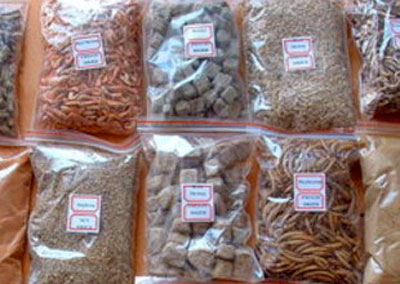1. Freeze-dried cottage cheese lasts 30 years
unrefrigerated.
Freeze-dried-food companies
sell their cuisine for long-term storage in one-gallon,
nitrogen-sealed cans that are advertised to last 25 to 30 years
unopened and another one to two weeks once opened.
The wares of
Mountain House, a prominent vendor, include a can of diced beef
that retails for $52.49, a can of freeze-dried cottage cheese
for $65.39, and a 16-serving can of scrambled eggs with bacon
for $31.89.
Tim Hemmingway, an employee at
Food Insurance,
recently ate a 37-year-old can of freeze-dried beef stew to
prove its longevity.
2. Economic hardship and natural
disasters propel people to store food.
The modern industry of
freeze-dried food storage arose in the late 1970s, when
widespread concern over the oil crises of 1973 and 1979 and
stagflation led many to stockpile food. In recent months the
economic downturn prompted a spike in sales of freeze-dried
foods.
The founders of
Shelf Reliance, a food-storage start-up
born in 2004, say their company tripled in size from February to
March of this year and again doubled in size from March to
April.
In January, Mountain House sold out of its one-gallon
cans. Unable to meet demand, the company recently had to
temporarily remove the cans from their website. In March, right
after the earthquake in Japan, they could be found on eBay for
two to three times their retail price.
3. Freeze-drying food requires a lot
of energy.
Freeze-drying is one of the
most energy-intensive ways to preserve food, according to R.
Paul Singh, a University of California-Davis food science and
technology professor.
Mountain House freeze-dries its food in
3,000-pound batches over a period of 18 to 20 hours. The final
product weights about 900 pounds and takes about 2.4 million Btu
of heat to produce - 1.2 times more energy than canning, and 1.7
times more energy than freezing.
4. Mormons are food-storage
aficionados.
The Church of Jesus Christ of
Latter-day Saints encourages members always to store one year's
supply of food - in fact, many food-storage companies were
founded specifically to serve the
Mormon community. Shelf
Reliance is one such company.
Born seven years ago in Lindon,
Utah, it has now expanded well beyond the Mormon market,
operating in all 50 states, boasting some 75,000 online
customers and selling an estimated $2.4 million worth of
freeze-dried food, storage containers, and emergency products
annually.
5. Freeze-dried food is relatively
healthy.
Gary Stoner, a professor of
medicine at the Medical College of Wisconsin, found that the
freeze-dried berries retained 90 percent of their
anthocyanins -
compounds that give berries their color and are thought to
prevent cancer.
Other nutrients, such as vitamins C and E and
folic acid, are somewhat depleted through the freeze-drying
process. Once rehydrated, freeze-dried food is similar in
nutritional value to fresh food according to Diane Barrett, a
food science and technology professor at UC-Davis. Barrett calls
freeze-drying "one of the best ways to preserve food."
Freeze-dried food has long been popular with outdoor enthusiasts
and shoppers at sporting-goods stores such as REI, which sells
small, lightweight packets for hiking and backpacking.
6. Freeze-drying is a really, really
old technique.
Freeze-drying is a three-step
process that begins with freezing. Next the food is placed in a
vacuum chamber under low heat. The frozen water crystals
evaporate directly from ice to water vapor in a process called
sublimation.
The food then undergoes "secondary drying," in
which any remaining water molecules are removed under slightly
higher temperatures. The food is nitrogen sealed for storage to
prevent contamination from water or oxygen.
As far back as 1200
A.D., the Incas freeze-dried potatoes (chuño) and a precursor to
beef jerky (charqui), placing food on high-elevation stone
platforms to freeze overnight and then dry in the sun.
7. Freeze-dried food can be pretty
tasty.
I was dubious staring down
into a paper sample cup of freeze-dried ground beef at the tea
party expo.
How could this taste like anything other than
cardboard? When I mustered the courage to toss the cup's
contents into my mouth, I was surprised to find that once
rehydrated, the beef tasted good and oddly similar to my mom's
tacos - a childhood dinnertime staple prepared with Old El Paso
taco seasoning packets.
That said, rehydration is key to your
enjoyment of freeze-dried food. I recently bought a package of
freeze-dried blueberries only to discover that right out of the
bag they have the flavor of the berry - but the texture of
Styrofoam.

